Recent Progress in Electromagnetic Wave Absorption Coatings: From Design Principles to Applications
Abstract
:1. Introduction
2. Design Principles of EM Absorption Coatings
2.1. Impedance Matching
2.2. Magnetic Dissipation
2.3. Dielectric Dissipation
2.4. Multiple Reflections
3. Feedstocks of EM Absorption Coatings
3.1. Matrices
3.1.1. Polymer Matrices
3.1.2. Ceramic Matrices
3.2. EM Absorbers
3.2.1. Carbon Materials
3.2.2. Metallic Composites
Metallic Nanomaterials
MXenes
MOF and Its Derivatives
3.2.3. Ferromagnetic Materials
3.2.4. Metamaterials
4. Fabrication Techniques of EM Absorption Coatings
4.1. Thermal Spraying Coating
4.2. Liquid Processing Coating
4.3. Vapor Deposition Coating Technology
5. Performance Evaluation of EM Absorption Coatings
5.1. Measurement of Absorption Properties
5.2. Measurement of Dielectric Dissipation
5.3. Measurement of Hysteresis Dissipation
5.4. Evaluation of Aging Resistance Performance
6. Application of EM Absorption Coatings
6.1. Broadband Absorption Coatings for Anti-Radar Stealth
6.2. Millimeter-Wave Absorption Coatings for 5G
6.3. Decametric-Wave Absorption Coatings for EM Shielding Suit
7. Conclusions and Outlook
Author Contributions
Funding
Institutional Review Board Statement
Informed Consent Statement
Data Availability Statement
Acknowledgments
Conflicts of Interest
References
- Zhao, Y.; Ji, G. Multi-Spectrum Bands Compatibility: New Trends in Stealth Materials Research. Sci. China Mater. 2022, 65, 2936–2941. [Google Scholar] [CrossRef]
- Pattanaik, B.; Chauhan, A. A Study of Stealth Technology. Mater. Today Proc. 2023, 81, 543–546. [Google Scholar] [CrossRef]
- Liu, T.-T.; Fang, Y.-S.; Zhu, Y.-H.; Cao, M.-S. Green Building Materials Lit up by Electromagnetic Absorption Function: A Review. J. Mater. Sci. Technol. 2022, 112, 329–344. [Google Scholar] [CrossRef]
- Xie, S.; Ji, Z.; Zhu, L.; Zhang, J.; Cao, Y.; Chen, J.; Liu, R.; Wang, J. Recent Progress in Electromagnetic Wave Absorption Building Materials. J. Build. Eng. 2020, 27, 100963. [Google Scholar] [CrossRef]
- Lin, E.C. Radiation Risk from Medical Imaging. Mayo Clin. Proc. 2010, 85, 1142–1146. [Google Scholar] [CrossRef]
- Frank, J.W. Electromagnetic Fields, 5G and Health: What about the Precautionary Principle? J. Epidemiol. Community Health 2021, 75, 562–566. [Google Scholar] [CrossRef]
- Zhu, Y.; Mao, B.; Kato, N. IRS-aided High-Accuracy Positioning for Autonomous Driving Towards 6G: A Tutorial. IEEE Veh. Technol. Mag. 2024, 19, 85–92. [Google Scholar] [CrossRef]
- Cheng, J.; Li, C.; Xiong, Y.; Zhang, H.; Raza, H.; Ullah, S.; Wu, J.; Zheng, G.; Cao, Q.; Zhang, D.; et al. Recent Advances in Design Strategies and Multifunctionality of Flexible Electromagnetic Interference Shielding Materials. Nanomicro. Lett. 2022, 14, 80. [Google Scholar] [CrossRef]
- Liang, C.; Qiu, H.; Zhang, Y.; Liu, Y.; Gu, J. External Field-Assisted Techniques for Polymer Matrix Composites with Electromagnetic Interference Shielding. Sci. Bull. 2023, 68, 1938–1953. [Google Scholar] [CrossRef] [PubMed]
- Tian, K.; Hu, D.; Wei, Q.; Fu, Q.; Deng, H. Recent Progress on Multifunctional Electromagnetic Interference Shielding Polymer Composites. J. Mater. Sci. Technol. 2023, 134, 106–131. [Google Scholar] [CrossRef]
- Ghazanfarpour, M.; Kashani, Z.A.; Pakzad, R.; Abdi, F.; Rahnemaei, F.A.; Akbari, P.A.; Roozbeh, N. Effect of Electromagnetic Field on Abortion: A Systematic Review and Meta-Analysis. Open Med. 2021, 16, 1628–1641. [Google Scholar] [CrossRef] [PubMed]
- Thaker, J.P.; Patel, M.B.; Jongnarangsin, K.; Liepa, V.V.; Thakur, R.K. Electromagnetic Interference with Pacemakers Caused by Portable Media Players. Heart Rhythm. 2008, 5, 538–544. [Google Scholar] [CrossRef]
- Upadhyay, S.; Upadhya, A.; Salehi, W.; Gupta, G. The Medical Aspects of EMI Effect on Patients Implanted with Pacemakers. Mater. Today Proc. 2021, 45, 5243–5248. [Google Scholar] [CrossRef]
- Wang, Y.; Pan, M.; Liang, X.; Li, B.; Zhang, S. Electromagnetic Wave Absorption Coating Material with Self-Healing Properties. Macromol. Rapid Commun. 2017, 38, 170047. [Google Scholar] [CrossRef] [PubMed]
- Ganguly, S.; Kanovsky, N.; Das, P.; Gedanken, A.; Margel, S. Photopolymerized Thin Coating of Polypyrrole/Graphene Nanofiber/Iron Oxide onto Nonpolar Plastic for Flexible Electromagnetic Radiation Shielding, Strain Sensing, and Non-Contact Heating Applications. Adv. Mater. Interfaces 2021, 8, 2101255. [Google Scholar] [CrossRef]
- Wang, X.; Lei, Z.; Ma, X.; He, G.; Xu, T.; Tan, J.; Wang, L.; Zhang, X.; Qu, L.; Zhang, X. A Lightweight MXene-Coated Nonwoven Fabric with Excellent Flame Retardancy, EMI Shielding, and Electrothermal/Photothermal Conversion for Wearable Heater. Chem. Eng. J. 2022, 430, 132605. [Google Scholar] [CrossRef]
- de Lustrac, A.; Ratni, B.; Piau, G.-P.; Duval, Y.; Burokur, S.N. Tri-State Metasurface-Based Electromagnetic Screen with Switchable Reflection, Transmission, and Absorption Functionalities. ACS Appl. Electron. Mater. 2021, 3, 1184–1190. [Google Scholar] [CrossRef]
- Wei, L.; Ma, J.; Ma, L.; Zhao, C.; Xu, M.; Qi, Q.; Zhang, W.; Zhang, L.; He, X.; Park, C.B. Computational Optimizing the Electromagnetic Wave Reflectivity of Double-Layered Polymer Nanocomposites. Small Methods 2022, 6, 2101510. [Google Scholar] [CrossRef]
- Dobák, S.; Beatrice, C.; Tsakaloudi, V.; Fiorillo, F. Magnetic Losses in Soft Ferrites. Magnetochemistry 2022, 8, 60. [Google Scholar] [CrossRef]
- Quan, B.; Liang, X.; Ji, G.; Cheng, Y.; Liu, W.; Ma, J.; Zhang, Y.; Li, D.; Xu, G. Dielectric Polarization in Electromagnetic Wave Absorption: Review and Perspective. J. Alloys Compd. 2017, 728, 1065–1075. [Google Scholar] [CrossRef]
- Panahi-Sarmad, M.; Samsami, S.; Ghaffarkhah, A.; Hashemi, S.A.; Ghasemi, S.; Amini, M.; Wuttke, S.; Rojas, O.; Tam, K.C.; Jiang, F.; et al. MOF-Based Electromagnetic Shields Multiscale Design: Nanoscale Chemistry, Microscale Assembly, and Macroscale Manufacturing. Adv. Funct. Mater. 2024, 34, 2304473. [Google Scholar] [CrossRef]
- Mohammed, I.; Mohammed, J.; Srivastava, A.K. Recent Progress in Hexagonal Ferrites Based Composites for Microwave Absorption. Cryst. Res. Technol. 2023, 58, 2200200. [Google Scholar] [CrossRef]
- Xia, Y.; Gao, W.; Gao, C. A Review on Graphene-Based Electromagnetic Functional Materials: Electromagnetic Wave Shielding and Absorption. Adv. Funct. Mater. 2022, 32, 2204591. [Google Scholar] [CrossRef]
- Jiang, X.; Zhang, L.; Yin, L.; Yang, G.; Xie, J.; Zhang, L.; Lu, H.; Liang, D.; Deng, L. Corrosion Behavior of Fluorinated Carbonyl Iron-Hydrophobic Composites in Neutral Salt Spray Environment. Corros. Sci. 2023, 210, 110823. [Google Scholar] [CrossRef]
- Yuan, H.; Li, B.; Zhu, C.; Xie, Y.; Jiang, Y.; Chen, Y. Dielectric Behavior of Single Iron Atoms Dispersed on Nitrogen-Doped Nanocarbon. Appl. Phys. Lett. 2020, 116, 153101. [Google Scholar] [CrossRef]
- Liu, H.; Li, X.; Zhao, X.; Zhang, M.; Liu, X.; Yang, S.; Wu, H.; Ma, Z. Large Annular Dipoles Bounded between Single-Atom Co and Co Cluster for Clarifying Electromagnetic Wave Absorbing Mechanism. Adv. Funct. Mater. 2023, 33, 2304442. [Google Scholar] [CrossRef]
- Liang, H.; Chen, G.; Liu, D.; Li, Z.; Hui, S.; Yun, J.; Zhang, L.; Wu, H. Exploring the Ni 3d Orbital Unpaired Electrons Induced Polarization Loss Based on Ni Single-Atoms Model Absorber. Adv. Funct. Mater. 2023, 33, 2212604. [Google Scholar] [CrossRef]
- Ma, C.; Ma, W.; Wang, T.; Ma, F.; Xu, X.; Feng, C.; Wang, W. An MXene Coating with Electromagnetic Wave Absorbing Performance. Inorg. Chem. Commun. 2023, 151, 110565. [Google Scholar] [CrossRef]
- Verma, R.; Thakur, P.; Chauhan, A.; Jasrotia, R.; Thakur, A. A Review on MXene and Its’ Composites for Electromagnetic Interference (EMI) Shielding Applications. Carbon 2023, 208, 170–190. [Google Scholar] [CrossRef]
- Han, M.; Gogotsi, Y. Perspectives for Electromagnetic Radiation Protection with MXenes. Carbon 2023, 204, 17–25. [Google Scholar] [CrossRef]
- Zhao, Y.; Hao, L.; Zhang, X.; Tan, S.; Li, H.; Zheng, J.; Ji, G. A Novel Strategy in Electromagnetic Wave Absorbing and Shielding Materials Design: Multi-Responsive Field Effect. Small Sci. 2022, 2, 2100077. [Google Scholar] [CrossRef]
- Si, W.; Liao, Q.; Hou, W.; Chen, L.; Li, X.; Zhang, Z.; Sun, M.; Song, Y.; Qin, L. Low-Frequency Broadband Absorbing Coatings Based on MOFs: Design, Fabrication, Microstructure and Properties. Coatings 2022, 12, 766. [Google Scholar] [CrossRef]
- Faisal, N.H.; Ahmed, R.; Sellami, N.; Prathuru, A.; Njuguna, J.; Venturi, F.; Hussain, T.; Nezhad, H.Y.; Katiyar, N.K.; Goel, S.; et al. Thermal Spray Coatings for Electromagnetic Wave Absorption and Interference Shielding: A Review and Future Challenges. Adv. Eng. Mater. 2022, 24, 2200171. [Google Scholar] [CrossRef]
- Deng, Z.; Jiang, P.; Wang, Z.; Xu, L.; Yu, Z.; Zhang, H. Scalable Production of Catecholamine-Densified MXene Coatings for Electromagnetic Shielding and Infrared Stealth. Small 2023, 19, 2304278. [Google Scholar] [CrossRef]
- Xie, Y.; Liu, S.; Huang, K.; Chen, B.; Shi, P.; Chen, Z.; Liu, B.; Liu, K.; Wu, Z.; Chen, K.; et al. Ultra-Broadband Strong Electromagnetic Interference Shielding with Ferromagnetic Graphene Quartz Fabric. Adv. Mater. 2022, 34, 2202982. [Google Scholar] [CrossRef]
- Wang, T.; Chen, G.; Zhu, J.; Gong, H.; Zhang, L.; Wu, H. Deep Understanding of Impedance Matching and Quarter Wavelength Theory in Electromagnetic Wave Absorption. J. Colloid Interface Sci. 2021, 595, 1–5. [Google Scholar] [CrossRef] [PubMed]
- Huo, J.; Wang, L.; Yu, H. Polymeric Nanocomposites for Electromagnetic Wave Absorption. J. Mater. Sci. 2009, 44, 3917–3927. [Google Scholar] [CrossRef]
- Wei, H.; Zhang, Z.; Hussain, G.; Zhou, L.; Li, Q.; Ostrikov, K. Techniques to Enhance Magnetic Permeability in Microwave Absorbing Materials. Appl. Mater. Today 2020, 19, 100596. [Google Scholar] [CrossRef]
- Zhou, Y.; Wang, S.-J.; Li, D.-S.; Jiang, L. Lightweight and Recoverable ANF/RGO/PI Composite Aerogels for Broad and High-Performance Microwave Absorption. Compos. B Eng. 2021, 213, 108701. [Google Scholar] [CrossRef]
- Qin, M.; Zhang, L.; Wu, H. Dielectric Loss Mechanism in Electromagnetic Wave Absorbing Materials. Adv. Sci. 2022, 9, 2105553. [Google Scholar] [CrossRef]
- Zhang, J.; Ma, M.; Bi, Y.; Liao, Z.; Ma, Y.; Huang, W.; Lyu, P.; Feng, C. A Review of Epoxy-Based Composite Materials: Synthesis, Structure and Application for Electromagnetic Wave Absorption. J. Alloys Compd. 2022, 922, 166096. [Google Scholar] [CrossRef]
- Lee, S.H.; Kim, J.Y.; Koo, C.M.; Kim, W.N. Effects of Processing Methods on the Electrical Conductivity, Electromagnetic Parameters, and EMI Shielding Effectiveness of Polypropylene/Nickel-Coated Carbon Fiber Composites. Macromol. Res. 2017, 25, 936–943. [Google Scholar] [CrossRef]
- Duan, Y.; Liu, Y.; Cui, Y.; Ma, G.; Tongmin, W. Graphene to Tune Microwave Absorption Frequencies and Enhance Absorption Properties of Carbonyl Iron/Polyurethane Coating. Prog. Org. Coat. 2018, 125, 89–98. [Google Scholar] [CrossRef]
- Zhao, W.; Zhang, Q.; Zhang, H.; Zhang, J. Preparation of PS/Ag Microspheres and Its Application in Microwave Absorbing Coating. J. Alloys Compd. 2009, 473, 206–211. [Google Scholar] [CrossRef]
- Fu, Z.; Pang, A.; Luo, H.; Zhou, K.; Yang, H. Research Progress of Ceramic Matrix Composites for High Temperature Stealth Technology Based on Multi-Scale Collaborative Design. J. Mater. Res. Technol. 2022, 18, 2770–2783. [Google Scholar] [CrossRef]
- Wu, C.; Wang, J.; Zhang, X.; Kang, L.; Cao, X.; Zhang, Y.; Niu, Y.; Yu, Y.; Fu, H.; Shen, Z.; et al. Hollow Gradient-Structured Iron-Anchored Carbon Nanospheres for Enhanced Electromagnetic Wave Absorption. Nanomicro Lett. 2023, 15, 7. [Google Scholar] [CrossRef] [PubMed]
- Zhang, X.; Tian, X.; Qiao, J.; Fang, X.; Liu, K.; Liu, C.; Lin, J.; Li, L.; Liu, W.; Liu, J.; et al. In-Situ Fabrication of Sustainable-N-Doped-Carbon-Nanotube-Encapsulated CoNi Heterogenous Nanocomposites for High-Efficiency Electromagnetic Wave Absorption. Small 2023, 19, 2302686. [Google Scholar] [CrossRef] [PubMed]
- Liu, Y.; Wang, S.; Wang, Q.; Su, X. Electromagnetic and Microwave Absorption Properties of Flexible Fabric Coatings Containing Ag Decorated Spherical Graphene Powders with FSS Incorporation. Ceram. Int. 2024, 50, 11075–11084. [Google Scholar] [CrossRef]
- Yu, M.; Huang, Y.; Liu, X.; Zhao, X.; Fan, W.; She, K. In Situ Modification of MXene Nanosheets with Polyaniline Nanorods for Lightweight and Broadband Electromagnetic Wave Absorption. Carbon 2023, 208, 311–321. [Google Scholar] [CrossRef]
- Zheng, C.; Ning, M.; Zou, Z.; Lv, G.; Wu, Q.; Hou, J.; Man, Q.; Li, R. Two Birds with One Stone: Broadband Electromagnetic Wave Absorption and Anticorrosion Performance in 2–18GHz for Prussian Blue Analog Derivatives Aimed for Practical Applications. Small 2023, 19, 2208211. [Google Scholar] [CrossRef]
- Xie, T.; Li, S.; Ma, L.; Li, J.; Pang, S.; Hu, C.; Zhao, R.; Tang, S. Bimetallic MOF-Derived Composites with Broad Electromagnetic Wave Absorption and Strong Corrosion Resistance. Carbon 2023, 208, 33–42. [Google Scholar] [CrossRef]
- Zhang, X.; Tian, X.-L.; Qin, Y.; Qiao, J.; Pan, F.; Wu, N.; Wang, C.; Zhao, S.; Liu, W.; Cui, J.; et al. Conductive Metal–Organic Frameworks with Tunable Dielectric Properties for Boosting Electromagnetic Wave Absorption. ACS Nano 2023, 17, 12510–12518. [Google Scholar] [CrossRef]
- Liu, J.; Liang, H.; Wei, B.; Yun, J.; Zhang, L.; Wu, H. “Matryoshka Doll” Heterostructures Induce Electromagnetic Parameters Fluctuation to Tailor Electromagnetic Wave Absorption. Small Struct. 2023, 4, 2200379. [Google Scholar] [CrossRef]
- Li, G.; Ma, S.; Li, Z.; Zhang, Y.; Cao, Y.; Huang, Y. Temperature-Induced Self-Decomposition Doping of Fe3GeTe2 to Achieve Ultra-High Tc of 496K for Multispectral Compatible Strong Electromagnetic Wave Absorption. Adv. Funct. Mater. 2023, 33, 2210578. [Google Scholar] [CrossRef]
- Xia, W.; Li, C.; Zhang, S.; Wang, X.; Wang, S.; Yang, Q.; Li, W.; Xiong, C.; Huang, J.; Wang, Q. Ho-Ion-Polymer/Graphene Heterojunctions Toward Room-Temperature Ferromagnets. Small 2023, 19, 2300385. [Google Scholar] [CrossRef]
- An, Q.; Li, D.; Liao, W.; Liu, T.; Joralmon, D.; Li, X.; Zhao, J. A Novel Ultra-Wideband Electromagnetic-Wave-Absorbing Metastructure Inspired by Bionic Gyroid Structures. Adv. Mater. 2023, 35, 2300659. [Google Scholar] [CrossRef]
- Yao, L.; Yang, W.; Zhou, S.; Mei, H.; Li, Y.; Dassios, K.G.; Riedel, R.; Liu, C.; Cheng, L.; Zhang, L. Top-down Parametrization-Design of Orientation-Reinforced SiOC-Based Perfect Metamaterial Microwave Absorber with Wide-Temperature Adaptability. Acta Mater. 2023, 249, 118803. [Google Scholar] [CrossRef]
- Tao, J.; Zhou, J.; Yao, Z.; Jiao, Z.; Wei, B.; Tan, R.; Li, Z. Multi-Shell Hollow Porous Carbon Nanoparticles with Excellent Microwave Absorption Properties. Carbon 2021, 172, 542–555. [Google Scholar] [CrossRef]
- Zhang, F.; Jia, Z.; Zhou, J.; Liu, J.; Wu, G.; Yin, P. Metal-Organic Framework-Derived Carbon Nanotubes for Broadband Electromagnetic Wave Absorption. Chem. Eng. J. 2022, 450, 138205. [Google Scholar] [CrossRef]
- Liu, J.; Zhang, L.; Wu, H. Electromagnetic Wave-Absorbing Performance of Carbons, Carbides, Oxides, Ferrites and Sulfides: Review and Perspective. J. Phys. D Appl. Phys. 2021, 54, 203001. [Google Scholar] [CrossRef]
- Anasori, B.; Naguib, M. Two-Dimensional MXenes. MRS Bull. 2023, 48, 238–244. [Google Scholar] [CrossRef]
- Dai, B.; Ma, Y.; Dong, F.; Yu, J.; Ma, M.; Thabet, H.K.; El-Bahy, S.M.; Ibrahim, M.M.; Huang, M.; Seok, I.; et al. Overview of MXene and Conducting Polymer Matrix Composites for Electromagnetic Wave Absorption. Adv. Compos. Hybrid. Mater. 2022, 5, 704–754. [Google Scholar] [CrossRef]
- Fan, B.; Li, N.; Dai, B.; Shang, S.; Guan, L.; Zhao, B.; Wang, X.; Bai, Z.; Zhang, R. Investigation of Adjacent Spacing Dependent Microwave Absorption Properties of Lamellar Structural Ti3C2Tx MXenes. Adv. Powder Technol. 2020, 31, 808–815. [Google Scholar] [CrossRef]
- Zhou, X.; Li, S.; Zhang, M.; Yuan, X.; Wen, J.; Xi, H.; Wu, H.; Ma, X. MXene/PEO Aerogels with Two-Hierarchically Porous Architecture for Electromagnetic Wave Absorption. Carbon 2023, 204, 538–546. [Google Scholar] [CrossRef]
- Zhang, Y.; Ruan, K.; Zhou, K.; Gu, J. Controlled Distributed Ti3C2Tx Hollow Microspheres on Thermally Conductive Polyimide Composite Films for Excellent Electromagnetic Interference Shielding. Adv. Mater. 2023, 35, 2211642. [Google Scholar] [CrossRef] [PubMed]
- Niu, X.; Huang, P.; Wang, Y.; Zou, B. Preparation and Characterization of a Composite Ceramic Coating Containing Absorber LaFe12O19 by Plasma Spraying. Ceram. Int. 2023, 49, 27079–27085. [Google Scholar] [CrossRef]
- Ren, S.; Yu, H.; Wang, L.; Huang, Z.; Lin, T.; Huang, Y.; Yang, J.; Hong, Y.; Liu, J. State of the Art and Prospects in Metal-Organic Framework-Derived Microwave Absorption Materials. Nanomicro. Lett. 2022, 14, 68. [Google Scholar] [CrossRef] [PubMed]
- Hossain, M.D.; Hossain, M.A.; Sikder, S.S. Hysteresis Loop Properties of Rare Earth Doped Spinel Ferrites: A Review. J. Magn. Magn. Mater. 2022, 564, 170095. [Google Scholar] [CrossRef]
- Liu, Y.; Li, C.; Fang, B.; Chen, L.; Xu, J.; Liu, F.; Xu, L.; Li, X.; Tang, Y.; Hong, Z.; et al. Research Progress in Tunable Metamaterial Absorbers. Adv. Photonics Res. 2024, 5, 2300258. [Google Scholar] [CrossRef]
- Yao, H.; Qing, Y.; Li, Y.; Wen, J.; Li, W.; Cao, Y.; Luo, F. Effect of B4C Content and Annealing on Complex Permittivity and Microwave-Absorption Properties of B4C/Al2O3 Coatings. J. Eur. Ceram. Soc. 2023, 43, 1450–1458. [Google Scholar] [CrossRef]
- Huang, P.; Niu, X.; Wang, Y.; Zou, B. Ultra-broadband Electromagnetic Wave Absorption of Ceramic Composite Coating by Atmospheric Plasma Spraying. J. Am. Ceram. Soc. 2023, 106, 5832–5845. [Google Scholar] [CrossRef]
- Deng, Z.; Li, L.; Tang, P.; Jiao, C.; Yu, Z.-Z.; Koo, C.M.; Zhang, H.-B. Controllable Surface-Grafted MXene Inks for Electromagnetic Wave Modulation and Infrared Anti-Counterfeiting Applications. ACS Nano 2022, 16, 16976–16986. [Google Scholar] [CrossRef]
- Ma, Z.; Xiang, X.; Shao, L.; Zhang, Y.; Gu, J. Multifunctional Wearable Silver Nanowire Decorated Leather Nanocomposites for Joule Heating, Electromagnetic Interference Shielding and Piezoresistive Sensing. Angew. Chem. Int. Ed. 2022, 61, e202200705. [Google Scholar] [CrossRef]
- Wang, Y.; Li, J.; Li, W.; Ma, L.; Lin, J.; Ye, S.; Zhao, Q.; Liu, Y.; Zhao, S. Flexible Polypyrrole-Coated Polyamide Based Mats for Broadband Microwave Absorption and Electromagnetic Interference Shielding with Low Reflection. ACS Appl. Polym. Mater. 2023, 5, 2995–3004. [Google Scholar] [CrossRef]
- Wang, B.; Fu, Y.; Li, J.; Wu, Q.; Wang, X.; Liu, T. Construction of Co@C Nanocapsules by One-Step Carbon Reduction of Single-Crystal Co3O4 Nanoparticles: Ultra-Wideband Microwave Absorber Verified via Coaxial and Arch Methods. Chem. Eng. J. 2022, 445, 136863. [Google Scholar] [CrossRef]
- Wu, C.; Bi, K.; Yan, M. Scalable Self-Supported FeNi3/Mo2C Flexible Paper for Enhanced Electromagnetic Wave Absorption Evaluated via Coaxial, Waveguide and Arch Methods. J. Mater. Chem. C Mater. 2020, 8, 10204–10212. [Google Scholar] [CrossRef]
- Peng, M.; Qin, F. Clarification of Basic Concepts for Electromagnetic Interference Shielding Effectiveness. J. Appl. Phys. 2021, 130, 225108. [Google Scholar] [CrossRef]
- Costa, F.; Borgese, M.; Degiorgi, M.; Monorchio, A. Electromagnetic Characterisation of Materials by Using Transmission/Reflection (T/R) Devices. Electronics 2017, 6, 95. [Google Scholar] [CrossRef]
- Guo, Y.; Ruan, K.; Wang, G.; Gu, J. Advances and Mechanisms in Polymer Composites toward Thermal Conduction and Electromagnetic Wave Absorption. Sci. Bull. 2023, 68, 1195–1212. [Google Scholar] [CrossRef] [PubMed]
- Yang, Y.; Logesh, K.; Mehrez, S.; Huynen, I.; Elbadawy, I.; Mohanavel, V.; Alamri, S. Rational Construction of Wideband Electromagnetic Wave Absorber Using Hybrid FeWO4-Based Nanocomposite Structures and Tested by the Free-Space Method. Ceram. Int. 2023, 49, 2130–2139. [Google Scholar] [CrossRef]
- Samadpour, E.; Kiani, E.; Hosein Shams, M. Microwave Permeability and Electromagnetic Wave Absorption Properties of Co2Y Nanocomposites. Mater. Sci. Eng. B 2023, 298, 116825. [Google Scholar] [CrossRef]
- Shao, N.; Li, J.; Che, S.; Zheng, J.; Qiao, L.; Ying, Y.; Yu, J.; Li, W. L and S Band Microwave Absorption Properties of Z-Type Hexaferrite Ba3Co2Fe24O41 Synthesized at Low Temperature. J. Alloys Compd. 2023, 968, 171926. [Google Scholar] [CrossRef]
- Xia, L.; Wang, K.; Xu, W.; Kong, M.; Huang, Y.; Lv, Y.; Li, G. Synergistic Acceleration Effects of Ultraviolet and Salt Spray on the Degradation and Failure of Electromagnetic Wave-Absorbing Coatings. Prog. Org. Coat. 2023, 182, 107686. [Google Scholar] [CrossRef]
- Zhi, Q.; Wu, C.; Li, M.; Liu, J.; Zhang, R.; Min, Z.; Chen, Y.; Li, H.; Fan, B. Fe2AlB2: A Novel Ferromagnetic Material with Superior Electromagnetic Wave Absorption Performance. Ceram. Int. 2023, 49, 34182–34190. [Google Scholar] [CrossRef]
- Talebi, H.; Olad, A.; Nosrati, R. Fe3O4/PANI Nanocomposite Core-Shell Structure in Epoxy Resin Matrix for the Application as Electromagnetic Waves Absorber. Prog. Org. Coat. 2022, 163, 106665. [Google Scholar] [CrossRef]
- Qian, Y.; Tao, Y.; Li, W.; Li, Y.; Xu, T.; Hao, J.; Jiang, Q.; Luo, Y.; Yang, J. High Electromagnetic Wave Absorption and Thermal Management Performance in 3D CNF@C-Ni/Epoxy Resin Composites. Chem. Eng. J. 2021, 425, 131608. [Google Scholar] [CrossRef]
- Neethu, L.S.; Sudhi, S. Low Frequency Radar for Improving Radar Cross Section. In Proceedings of the 2023 International Conference on Control, Thiruvananthapuram, India, 19–21 May 2023. [Google Scholar] [CrossRef]
- Taj, Z.U.D.; Bilal, A.; Awais, M.; Salamat, S.; Abbas, M.; Maqsood, A. Design Exploration and Optimization of Aerodynamics and Radar Cross Section for a Fighter Aircraft. Aerosp. Sci. Technol. 2023, 133, 108114. [Google Scholar] [CrossRef]
- Shirke, N.; Ghase, V.; Jamdar, V. Recent Advances in Stealth Coating. Polym. Bull. 2024, 81, 1–30. [Google Scholar] [CrossRef]
- Song, R.; Mao, B.; Wang, Z.; Hui, Y.; Zhang, N.; Fang, R.; Zhang, J.; Wu, Y.; Ge, Q.; Novoselov, K.S.; et al. Comparison of Copper and Graphene-Assembled Films in 5G Wireless Communication and THz Electromagnetic-Interference Shielding. Proc. Natl. Acad. Sci. USA 2023, 120, e2209807120. [Google Scholar] [CrossRef]
- Li, J.; Tsai, M.; Chiu, R.; He, E.; Hsieh, A.; Tsai, M.-F.; Chu, F.; Chen, J.Y.; Jian, S.; Chen, S.; et al. EMI Shielding Technology in 5G RF System in Package Module. In Proceedings of the 2020 IEEE 70th Electronic Components and Technology Conference (ECTC), Orlando, FL, USA, 5 August 2020. [Google Scholar] [CrossRef]
- Pethig, R. Dielectric properties of body tissues. Clin. Phys. Physiol. Meas 1987, 8, 5–12. [Google Scholar] [CrossRef]
- Malarić, K.; Šaravanja, B.; Pušić, T. Microwave Radiation Protective Suit with Silver Threads. In Proceedings of the 4th International Conference on Smart Grid Metrology (SMAGRIMET), Cavtat, Croatia, 24–28 April 2023. [Google Scholar] [CrossRef]
- Zhao, H.; Hou, L.; Bi, S.; Lu, Y. Enhanced X-Band Electromagnetic-Interference Shielding Performance of Layer-Structured Fabric-Supported Polyaniline/Cobalt–Nickel Coatings. ACS Appl. Mater. Interfaces 2017, 9, 33059–33070. [Google Scholar] [CrossRef] [PubMed]
- Liu, W.; Sun, D.; Ma, H.; Chen, Z.; Gui, C.; Huang, J. A Facile Process Combined with Electroless Deposition and Hydrophobic Treatment to Fabricate Self-Cleaning Radiation Protection Suits for Pregnant Woman. Fibers Polym. 2022, 23, 1309–1317. [Google Scholar] [CrossRef]
- Zhou, S.; Dong, J.; Li, X.; Zhao, X.; Zhang, Q. Continuous Surface Metallization of Polyimide Fibers for Textile-Substrate Electromagnetic Shielding Applications. Adv. Fiber Mater. 2023, 5, 1892–1904. [Google Scholar] [CrossRef]
- Gui, C.; Sun, D.; Liu, W.; Ma, H.; Chen, Z.; Li, P.; Huang, J. Electroless Plating Process for the Manufacture of Radiation Protection Suits for Pregnant Woman: Effect of Bending on Its Electromagnetic Shielding Performance. J. Ind. Text. 2022, 51, 3176S–3187S. [Google Scholar] [CrossRef]

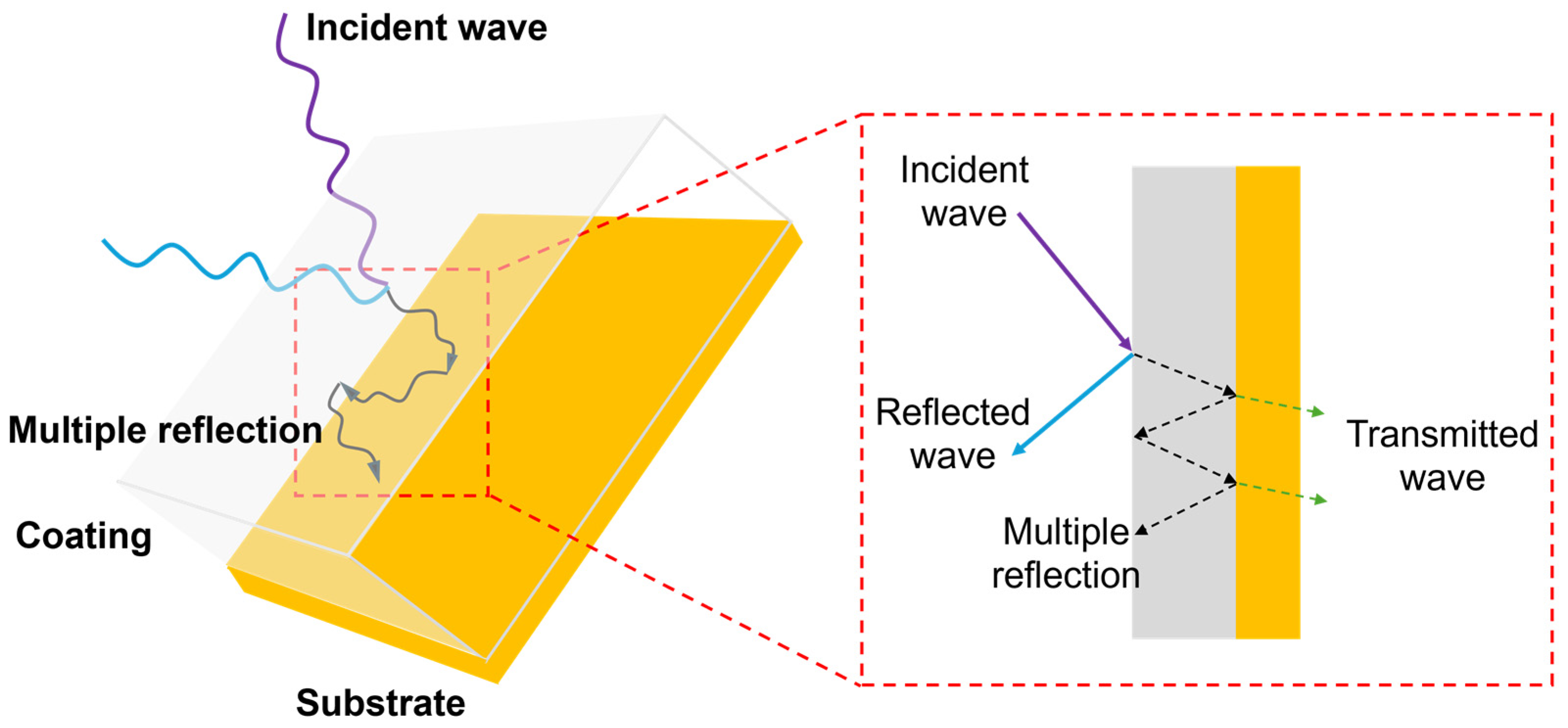





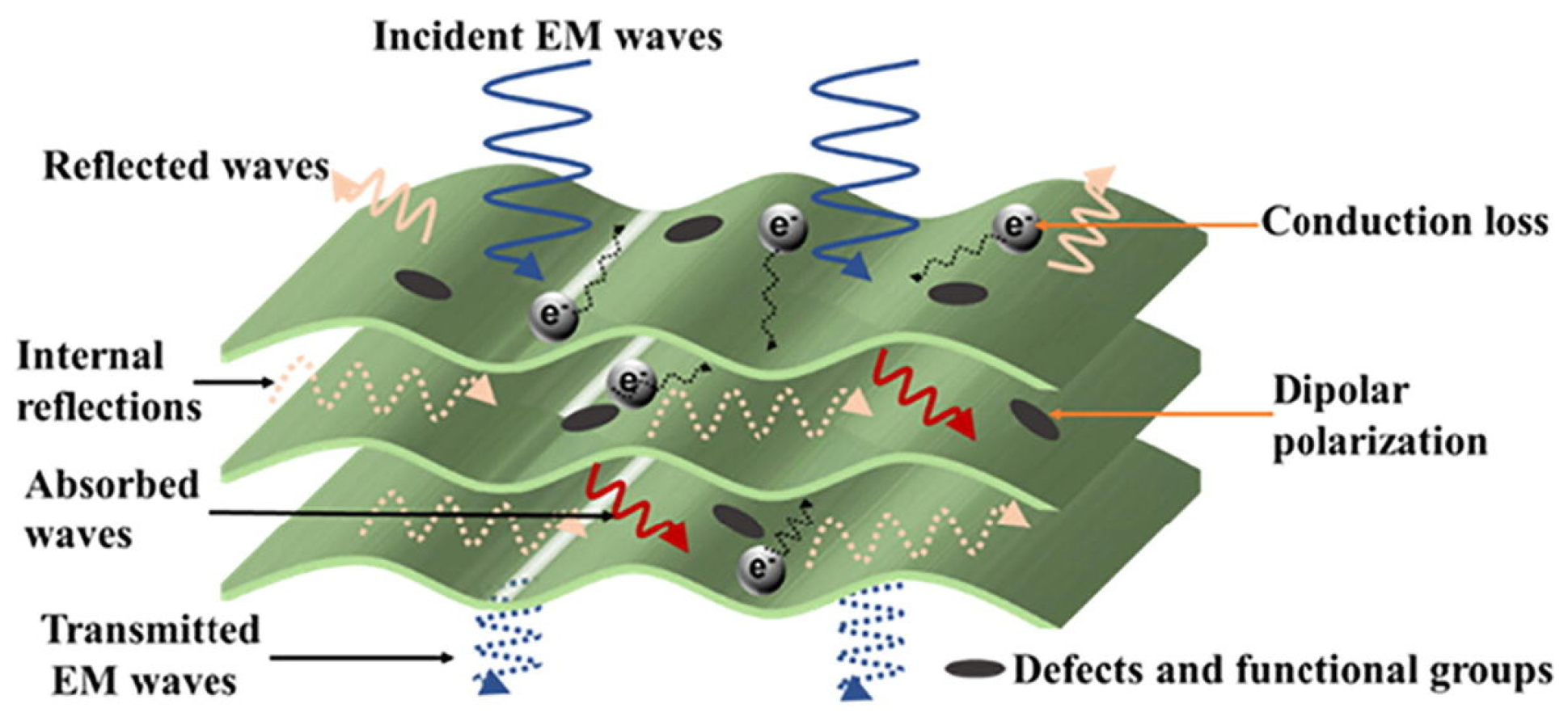


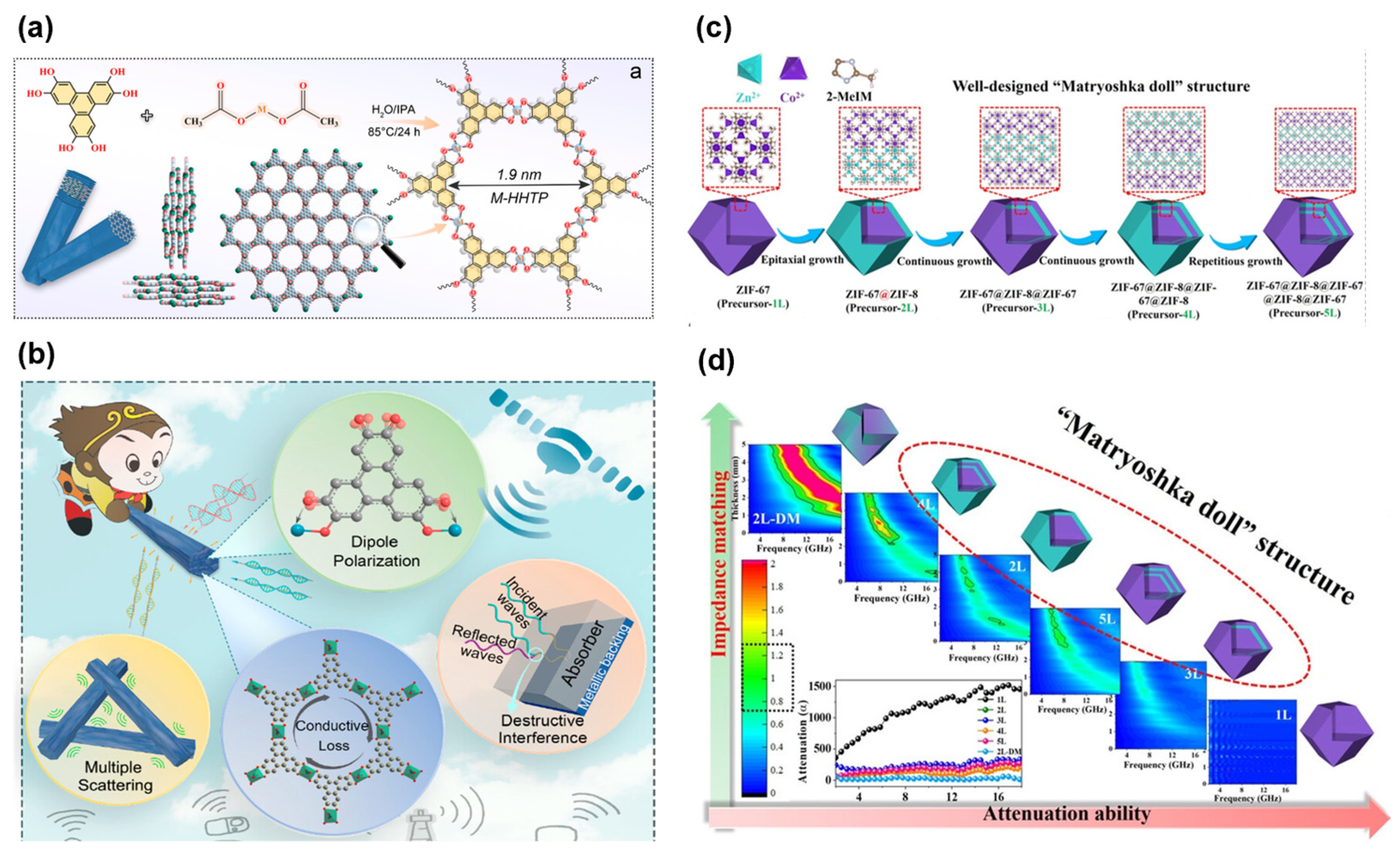



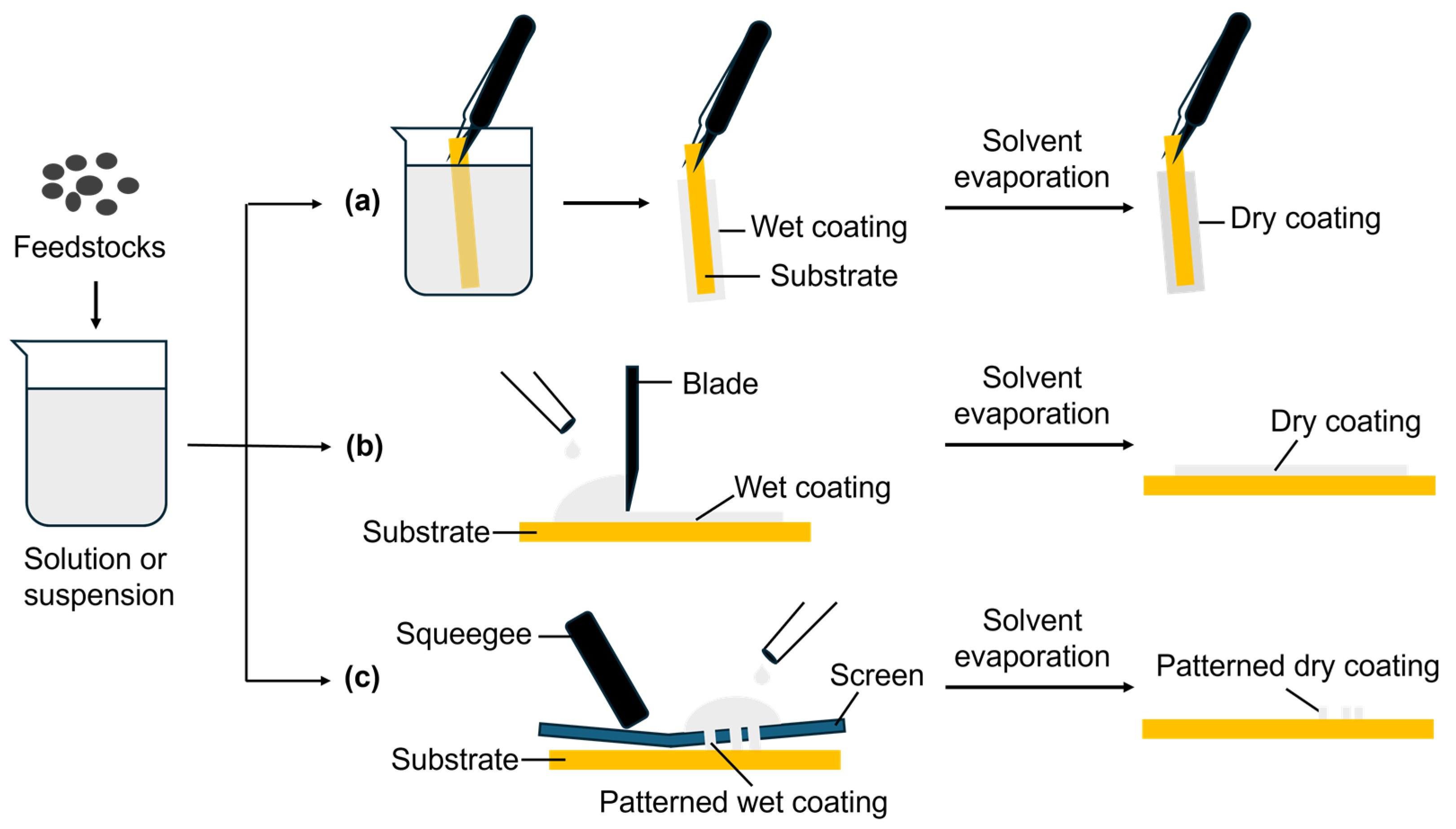


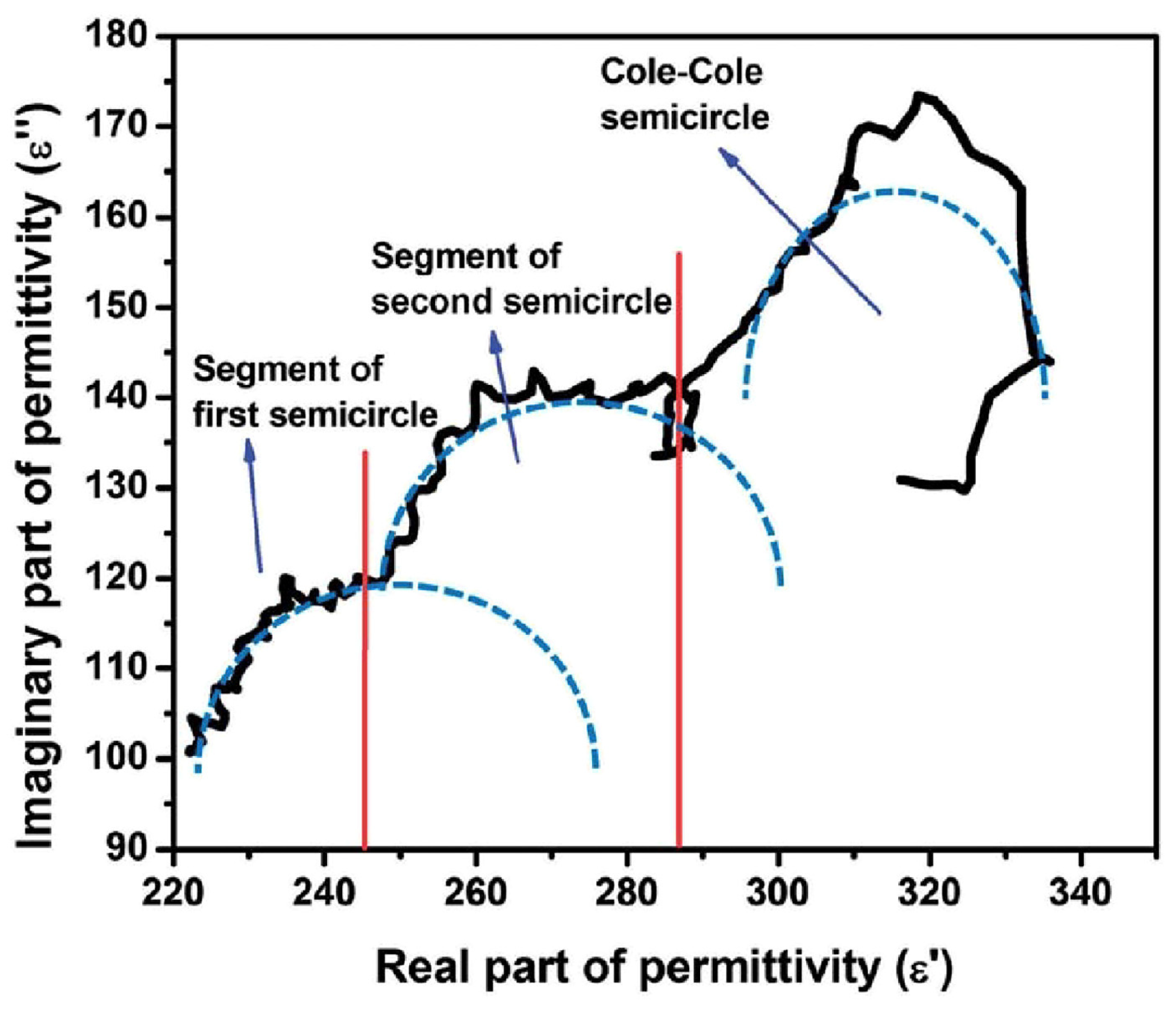




| Kind of Absorbers | Name | * | ** | Dominate Dissipation Mechanism | Typical Operating Frequencies (GHz) *** | RLmin (dB) | Reference |
|---|---|---|---|---|---|---|---|
| carbon materials | Fe/C hollow sphere | 0.50~1.00 | ≈0.05 | dielectric | 6~18 | −62.7 | [46] |
| N-CNTs encapsulated Co/Ni | 0.05~0.55 | −0.1~0.1 | dielectric | 6~10 | −84.0 | [47] | |
| Ag@SG | 0.27~0.325 | / | dielectric | 9~12 | −15 | [48] | |
| metallic composites | Ni-SAs/NC | 0.20~0.60 | ≈0.0 | dielectric | 8~14 | −36.4 | [27] |
| Co1+Cs/NGC | 0.30~0.75 | ≈0.0 | dielectric | 10~18 | −54.3 | [26] | |
| MXene/polyaniline | 0.2~1.2 | 0.0~0.4 | dielectric | 5~11 | −60.6 | [49] | |
| NiCoFe@C | ≈0.33 | 0.07~0.15 | dielectric and magnetic | 9~11 | −47.6 | [50] | |
| Ni/Ni3ZnC0.3 | 0.5~1.5 | 0.05~0.2 | dielectric and magnetic | 12~18 | −56.8 | [51] | |
| Zn-HHTP | 0.16~0.23 | / | dielectric | 2~10 | −62.8 | [52] | |
| MOF@MOF | 0.20~0.95 | −0.3~0.3 | dielectric | 10~18 | −40 | [53] | |
| ferromagnetic materials | RGO@FGT | 0.4~1.0 | −0.2~0.15 | dielectric and magnetic | 11~14 | −61 | [54] |
| P[AVIm][HoCl4]/rGO | 0.2~0.35 | 0.05~0.25 | magnetic | 10.5−15.6 | −57.32 | [55] | |
| metamaterials | gyroid structured carbon-based material | / | / | dielectric | 2~40 | −40 | [56] |
| TPMS-Shellular structured SiOC ceramics | 0.41~0.56 | / | dielectric | 12~18 | −72.38 | [57] |
| Fabrication Techniques | Advantages | Limitations | Suitability for Specific Material Types | Reference |
|---|---|---|---|---|
| thermal spray coating | versatile; rapid; reparable | high temperatures may damage EM absorbers | heat-resistant materials | [33,66] |
| liquid processing coating | low-cost; convenient | material wasting | soluble materials or materials that are dispersible in liquid | [34] |
| vapor deposition coating | excellent durability; precisely controllable | slow growth rate of coatings | materials with volatilizable precursors | [35] |
| Kind of EM Absorption Coatings | EM Absorber | Maxtrix | RLmin | Reference | ||
|---|---|---|---|---|---|---|
| dB | GHz * | Mm ** | ||||
| Ceramic coatings | LaFe12O19 | MgO/Al2O3 | −39.30 | 4.4 | 4.5 | [66] |
| Ba4Fe2.6Dy1.4Nb8O30 | oxidized FeSiAl alloy | −48.20 | 4.0 | 3.5 | [71] | |
| Fe2AlB2 | / | −47.39 | 15.2 | 1.2 | [84] | |
| Polymeric coatings | Fe3O4/PANI | epoxy resin | −34.28 | 11.2 | 2 | [85] |
| CNF@Ni-C | epoxy resin | −49.77 | 13.44 | 2.2 | [86] | |
| carbonyl iron/graphene | PU | −30.1 | 15.6 | 1 | [43] | |
| Metamaterial coatings | gyroid structured carbon-based material | / | −40 | 31 | 15 | [56] |
| TPMS-Shellular structured SiOC ceramics | / | −72.38 | 10.34 | 3.57 | [57] | |
Disclaimer/Publisher’s Note: The statements, opinions and data contained in all publications are solely those of the individual author(s) and contributor(s) and not of MDPI and/or the editor(s). MDPI and/or the editor(s) disclaim responsibility for any injury to people or property resulting from any ideas, methods, instructions or products referred to in the content. |
© 2024 by the authors. Licensee MDPI, Basel, Switzerland. This article is an open access article distributed under the terms and conditions of the Creative Commons Attribution (CC BY) license (https://creativecommons.org/licenses/by/4.0/).
Share and Cite
Jin, Y.; Yu, H.; Wang, Y.; Wang, L.; Nan, B. Recent Progress in Electromagnetic Wave Absorption Coatings: From Design Principles to Applications. Coatings 2024, 14, 607. https://doi.org/10.3390/coatings14050607
Jin Y, Yu H, Wang Y, Wang L, Nan B. Recent Progress in Electromagnetic Wave Absorption Coatings: From Design Principles to Applications. Coatings. 2024; 14(5):607. https://doi.org/10.3390/coatings14050607
Chicago/Turabian StyleJin, Yang, Haojie Yu, Yun Wang, Li Wang, and Bohua Nan. 2024. "Recent Progress in Electromagnetic Wave Absorption Coatings: From Design Principles to Applications" Coatings 14, no. 5: 607. https://doi.org/10.3390/coatings14050607
APA StyleJin, Y., Yu, H., Wang, Y., Wang, L., & Nan, B. (2024). Recent Progress in Electromagnetic Wave Absorption Coatings: From Design Principles to Applications. Coatings, 14(5), 607. https://doi.org/10.3390/coatings14050607








